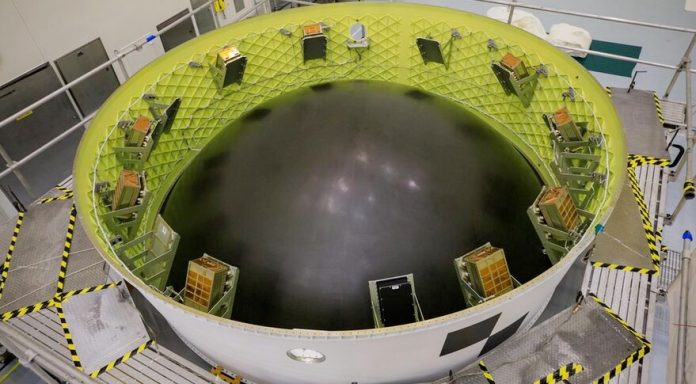
COLORADO SPRINGS — While most of the cubesats manifested to launch as secondary payloads on the first Space Launch System mission have arrived, at least one of them will miss its flight.
NASA selected 13 cubesats several years ago to fly as secondary payloads on the Artemis 1 mission, launching no earlier than November. The cubesats, each six units in size, come from a mix of NASA, international and academic developers.
NASA released an image Aug. 11 showing the Orion stage adapter, the component that links the Orion spacecraft to the SLS second stage and which hosts the cubesats that will be deployed during the mission. The image shows nine cubesats installed on the adapter and the other four slots still unoccupied.
One of those four slots will be filled by BioSentinel, a NASA cubesat that will study the long-term effects of radiation in deep space on organisms, in this case yeast. That spacecraft has arrived at the Kennedy Space Center, NASA spokesperson Shannon Segovia said Aug. 19, but will be installed on the adapter last to preserve the biological samples onboard.
Two of the other three cubesats are part of NASA’s Cube Quest Challenge, a competition held by the agency’s Centennial Challenges prize program. NASA spokesperson Molly Porter said that one of them, CU-3E from the University of Colorado Boulder, is still expected to arrive in time for the Artemis 1 launch, but that the other, Cislunar Explorers from Cornell University, will not be ready for the flight. A third Cube Quest cubesat, Team Miles, has been installed on the stage adapter.
The other cubesat is Lunar Flashlight, being developed at NASA’s Jet Propulsion Laboratory to look for water ice deposits on the moon using lasers. That spacecraft is in danger of missing the Artemis 1 because of delays in the development of its propulsion system, JPL spokesperson Ian O’Neill said Aug. 20.
“Due to significant issues during testing of the originally procured Lunar Flashlight propulsion system, the mission switched to development of an alternative. This change occurred late in the project and delayed mission readiness,” NASA said in a statement about the cubesat. The pandemic then slowed development of the new propulsion system, which uses a “green” nontoxic propellant, by a group led by the Georgia Institute of Technology.
JPL has received the propulsion system, but O’Neill said it wasn’t clear that the system would be fully integrated and tested in time to launch on Artemis 1. “NASA is also exploring several near-term commercial launch opportunities for Lunar Flashlight in case it does not make Artemis 1,” the agency stated.
Exactly how much time CU-3E and Lunar Flashlight have to make Artemis 1 isn’t clear. Segovia said the cubesats must arrive in time to be installed on the Orion stage adapter before that adapter is installed on the SLS. NASA KSC spokesperson Tiffany Fairley said that installation is currently scheduled for early fall.
During a panel discussion at the AIAA Propulsion and Energy Forum Aug. 10, David Reynolds of NASA’s Marshall Space Flight Center said that the pandemic had caused some of the secondary payloads to fall behind schedule. “We’re trying to give them some opportunity to get caught up,” he said.
NASA is doing so by delaying the installation of the Orion stage adapter for as long as possible, using a mass simulator in its place for tests inside the Vehicle Assembly Building at KSC. “That will allow them to load in some of those secondary payloads for another month and a half,” he said.
Reynolds noted that the current planning date for the Artemis 1 launch is Nov. 26. “I wouldn’t book nonrefundable flights just yet,” he added.
– Advertisement –